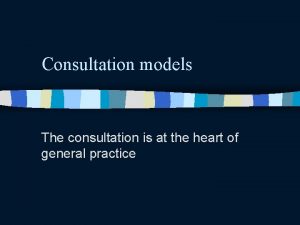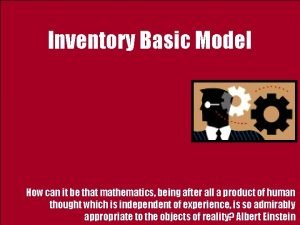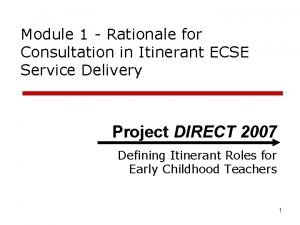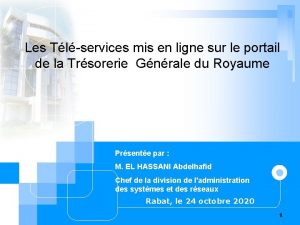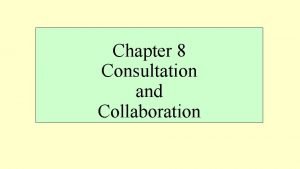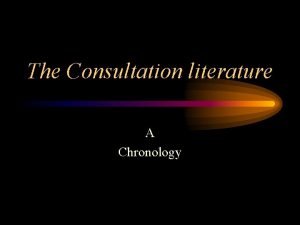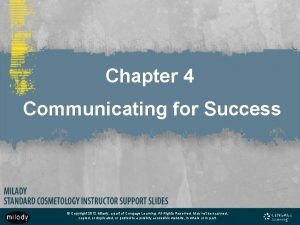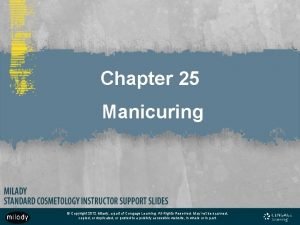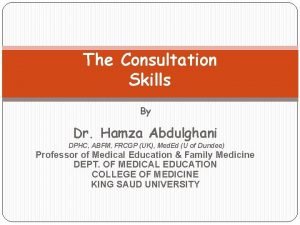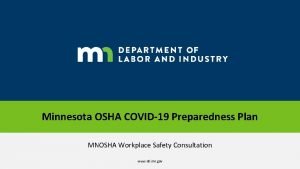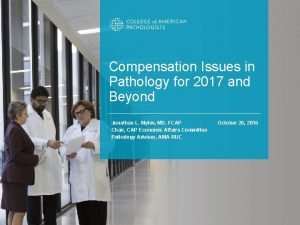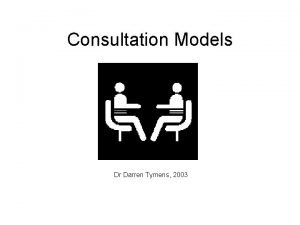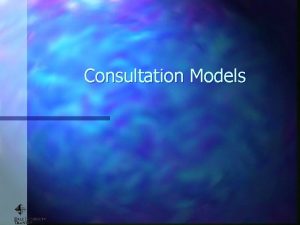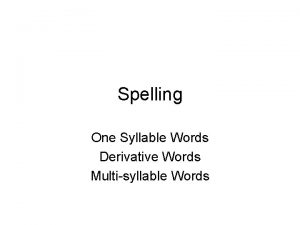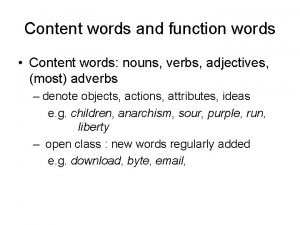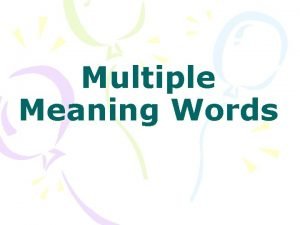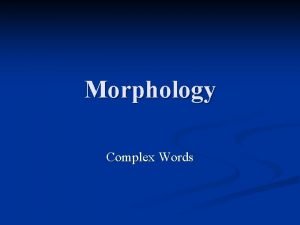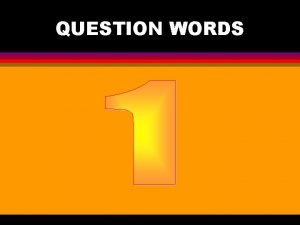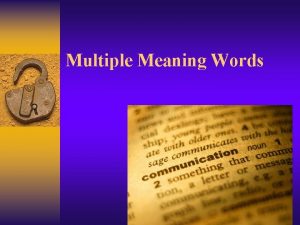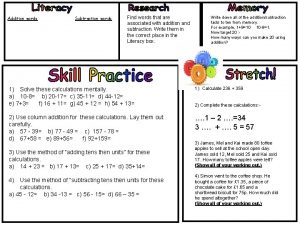Consultation Models Words are of course the most









































- Slides: 41

Consultation Models "Words are, of course, the most powerful drug used by mankind" Rudyard Kipling

Introduction • Models enable the Dr to think where in the consultation the problems are, • There are lots of models. • Task orientated, Skills based, • • Some are based on the doctor patient relationship, or the patients perspective of illness.

What models do you know?

Consultation models • • • 1957 M Balint - The Doctor, His Patient and The Illness 1964 E Berne - Games People Play 1975 Becker & Maiman - Sociobehavioural Determinants of Compliance. . . 1975 J Heron - Six Category Intervention Analysis 1976 Byrne & Long - Doctors Talking to Patients 1977 RCGP definition - Physical, psychological & social. . . 1979 Stott & Davis - The Exceptional Potential in Each Primary Care Consultation 1981 C Helman - Disease vs Illness in Gen Practice 1984 Pendleton et al - The Consultation 1987 R Neighbour - The Inner Consultation 1987 R C Fraser - Clinical Method: A Gen Pract Approach 1996 Kurtz & Silverman The Calgary-Cambridge Observation Guide to The Consultation

Traditional medical model The classic medical diagnostic process involves the following steps: • observation - history and examination • hypothesis -provisional diagnosis • hypothesis testing - investigations • deduction - definitive diagnosis.

Cases

Clinical Scenario 1 B • An elderly gentleman comes to see his doctor and is accompanied by his wife • As soon as the doctor asks what the problem is the wife starts taking over the consultation and doesn‘t seem to stop • she is worried that her husband is so lethargic all the time and withdrawn

Clinical Scenario 2 B • She also complains that he doesn‘t seem to respond to her and is worried that he might be depressed at least something must be wrong with him • The actual patient didn‘t have a chance so far to say anything

Clinical Scenario 3 B • After the wife has finished the doctor acknowledges his own feelings during this“epilog“ and feeds this back to the patient and his wife saying: I feel really overwhelmed at the moment, I don‘t know what to say • The patient counters: “this is exactly how I always feel so I just keep quiet“

Clinical Scenario 4 B • The wife is very astonished and says to her husband : “ Is that true? “ Why did you never tell me? • The husband responds saying: “ How could I, you were talking all the time. “ • The wife starts laughing: “ So I have to stop now, haven‘t I. “


Balint -1957 • Hungarian doctor and psychoanalyst • Founded with his wife Enid in the 1950 • This experince led to his book “The Doctor, his Patient and the Illness“ • Balint groups

Balints consultation approach • Psycological problems are often manifested physically and physical disease has psychological consequences • Passing responsibility of dealing with a problem on to someone else was defined by Balint as“collusion of anonymity“

Balints consultation approach • Doctors have a therapeutic role in the consultation : drug doctor • Doctors feelings have a function in the consultation • Balint describes the „Flash technique“: the doctor becomes aware of his feelings and interprets this back to the patient

Balint • The apostolic function • The drug doctor • The sick role • The long consultation • Balint groups


Clinical scenario 1 T 60 yr widow, living alone, sister lives nearby. “no friends. . untidy house. . no interests” Wants gp to advise and solve these problems. Not depressed clinically. Had not considered any options on how she could solve her problems. Pt seemed “childlike” in her approach.

Clinical scenario 2 T Initially began by suggesting possible options she could implement and following her up afterwards. Pt never seemed to explore the options discussed and gradually became more “childish” in her discussion and reasons for not “doing her homework” I had taken on the role of the adult , she the child.

Transactional Analysis Eric Berne 1964

T-A model This model discusses the 3 “ego-states” • Parent - critical/caring. • Adult – logical. • Child – dependent. Believes human psyche is influenced by mother and infant intimacy and that infant style intimacy can develop in certain relationships including dr-pt.

T-A model Useful to recognise when a dr-pt relationship develops into a parent-child dynamic. Consultations may develop into games where the pts interests are not served. Need to try to recognise the new dynamic and try to have both dr and pt take on the adult role.


Roger Neighbour – The Hand • 5 checkpoints – Connecting – Summarising – Handing-over – Safety-netting – Housekeeping • Inner consultation – “ 2 heads” – the Organiser and the Responder


–Pendleton, Schofield, Tate and Havelock (1984) – (1) – – – – – i) the nature and history of the problems ii) their aetiology iii) the patient’s ideas, concerns and expectations iv) the effects of the problems (2) To consider other problems: i) continuing problems ii) at-risk factors (3) With the patient, to choose an appropriate action for each problem (4) To achieve a shared understanding of the problems with the patient (5) To involve the patient in the management and encourage him to accept appropriate responsibility – – – (6) (7) To define the reason for the patient’s attendance, including: To use time and resources appropriately: i) in the consultation ii) in the long term To establish or maintain a relationship with the patient which helps to achieve the other tasks.

Example 1 P Old Lady attending with backache 1. Define the reason why she is attending Give patient time to talk with open questions: “What can I do for you today” “Patient tells you her back hurts” Explore patients ideas, concerns expectations: Patient's Ideas: 'What do you think is the cause of your problem? ' Patient’s Concerns: 'What is it about this problem that worries you most? ' Patient’s Expectations: 'What did you think I should do about your problem today? ' Effects of the problem: ‘How is this problem affecting your life at the moment? ' “I thought it might be Osteoporosis and I am no longer going out as I might have a fall and break my bones!”

2. Consider other problems: Any red flags? ? ? 3. Involve patient into decision making “What would you like to do to make a decision? ” “Would you like to have DEXA scan or a physio assessment? ” 4. Give explanation of diagnosis and confirm understanding “Can you tell me what you have understood of the diagnosis? ”

5. Involve patient into management: “Would you like some calcium or biphosphonates? ” “Would you feel safer with a frame when you walk? ” 6. Use time and resources appropriately Do we really need a DEXA scan? How can we do a physio assessment? 7. Maintain a good relationship with the patient


Helman • 1) What has happened? This includes organising the symptoms and signs • • • into a recognisable pattern, and giving it a name or identity. 2) Why has it happened? This explains the aetiology or cause of the condition. 3) Why has it happened to me? This tries to relate the illness to aspects of the patient, such as behaviour, diet, body-build, personality or heredity. 4) Why now? This concern the timing of the illness and its mode of onset (sudden or slow) 5) What would happen to me if nothing were done about it? This considers its likely course, outcome, prognosis and dangers. 6) What are its likely effects on other people (family, friends, employers, workmates) if nothing were done about it? This includes loss of income or of employment, or a strain on family relationships. 7)What should I do about it or to whom should I turn for further help? Strategies for treating the condition, including self-medication, consultation with friends or family, or going to see a doctor.


Stott and Davis (areas to explore) Stott and Davis outlined four areas which can be explored each time a patient consults: 1. The identification & management of the presenting problem 2. Modification of the patient's help-seeking behaviour 3. The management of continuing problems 4. Opportunistic health promotion

Stott + Davis 2 • • nature of the problem the effect on the patient ideas concerns and expectations Why now 'Doctor' means teacher Teaching the natural history of minor illness and about self-medication Every doctor-patient encounter plants the seeds of future patterns of illness behaviour which will affect the overuse (and under-use) of medical services.

Continuing problems • GP, as the coordinator of the patients' health care • reviewing any coexisting conditions • better adherence to any management plans. • Health promotion can be improved by taking action when the patient attends for other reasons


Byrne and Long (phases of the consultation) • Byrne and Long studied over 2000 audio • • recordings and in 1976 described six phases in the consultation which give it a logical structure. The model is useful for analysing 'dysfunctional' consultations where the patient may be misunderstood and dissatisfied while the doctor may be frustrated. Byrne and Long also described a spectrum of consulting styles, one extreme being doctorcentred and the other, patient-centred.

The six phases of the consultation • 1. The doctor establishes a relationship with the patient • 2. The doctor discovers or attempts to discover the reason for the • • • attendance 3. The doctor conducts a verbal and/or physical examination 4. The doctor, the doctor and patient, or the patient (in that order of probability) consider the condition 5. The doctor and occasionally the patient detail further treatment or investigation 6. The consultation is terminated, usually by the doctor Dysfunctional consultations tended to have less silence and often phase 2 and/or phase 4 were not successfully completed.

consulting styles In the doctor-centred consulting style, the doctor: • dominates the consultation • asks direct, closed questions • rejects the patient's ideas • evades the patient's questions In the patient-centred consulting style, the doctor: • asks open questions • actively listens • challenges and reflects the patients' words and behaviour to allow them to express themselves in their own way

The Calgary-Cambridge approach to communication skills teaching (1996) • Suzanne Kurtz & Jonathan Silverman • Doctors and patients tend to carry out the four tasks of initiating the session, gathering information, giving information and closing the session roughly in sequence while relationshipbuilding is performed continuously during the other tasks.


 Insidan region jh
Insidan region jh Neighbours consultation model
Neighbours consultation model Bradford vts consultation models
Bradford vts consultation models Neighbour model of consultation
Neighbour model of consultation What is the difference between models and semi models
What is the difference between models and semi models One and a half brick wall
One and a half brick wall Course number and title
Course number and title Course interne moyenne externe
Course interne moyenne externe Most inventory models attempt to minimize
Most inventory models attempt to minimize Client centered case consultation
Client centered case consultation Coverage consultation grafton
Coverage consultation grafton Triadic consultation
Triadic consultation Www.tgr.gov.ma consultation
Www.tgr.gov.ma consultation Dteenergy.com/hec
Dteenergy.com/hec Consultation skills for pharmacy practice
Consultation skills for pharmacy practice Triadic consultation model
Triadic consultation model Balint model of consultation
Balint model of consultation Consultationskillsforpharmacy
Consultationskillsforpharmacy Deer oaks consultation services
Deer oaks consultation services Behavioral consultation
Behavioral consultation Milady client consultation form
Milady client consultation form Effleurage definition milady
Effleurage definition milady Home buyer consultation
Home buyer consultation Wedding consultation form
Wedding consultation form Consultation skills for pharmacy practice
Consultation skills for pharmacy practice Balint consultation model
Balint consultation model Service delivery consultation
Service delivery consultation Consultation collocation
Consultation collocation Neighbours inner consultation model housekeeping
Neighbours inner consultation model housekeeping Sdcc consultation portal
Sdcc consultation portal Pa osha consultation
Pa osha consultation Mn osha consultation
Mn osha consultation Pendleton consultation model
Pendleton consultation model Microslide consultation
Microslide consultation Hình ảnh bộ gõ cơ thể búng tay
Hình ảnh bộ gõ cơ thể búng tay Slidetodoc
Slidetodoc Bổ thể
Bổ thể Tỉ lệ cơ thể trẻ em
Tỉ lệ cơ thể trẻ em Gấu đi như thế nào
Gấu đi như thế nào Thang điểm glasgow
Thang điểm glasgow Chúa yêu trần thế alleluia
Chúa yêu trần thế alleluia Các môn thể thao bắt đầu bằng từ đua
Các môn thể thao bắt đầu bằng từ đua

